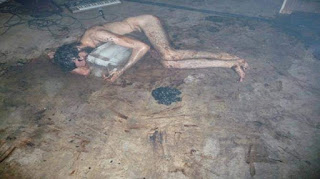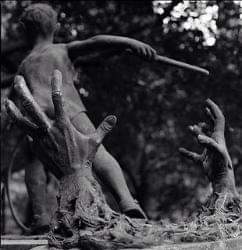This is Roopkund, a small glacial lake located at an altitude of about 5,029 metres in the Indian Himalayas
This is Roopkund, a small glacial lake located at an altitude of about 5,029 metres in the Indian Himalayas. This lake wouldn't be particularly interesting were it not for the skeletons found in the shallows.
Roopkund is frozen for most of the year, but when the snow and ice melts, the lake reveals a disturbing sight—skeletal remains belonging to hundreds of individuals, some of which still have flesh.
In 1942 a forest ranger rediscovered the skeletons. Initially it was believed that all the remains belonged to a Japanese invasion force. There is also a local legend that tells of a king and his entourage perishing in a hailstorm. It was believed that all the skeletons were deposited in a single event, but carbon dating on the skeletal remains of 38 individuals, 23 males and 15 females, has revealed that some of the skeletons date to between c. AD 700 and 1000, while others date to c. 1800. The earlier individuals who died at Roop Kund had South Asian ancestry, but those of 1800 had eastern Mediterranean ancestry, and one with South-east Asian ancestry.
The earlier skeletons were deposited over a period of time (with some possibly in a single event, such as a hailstorm, since some of the skulls have injuries that were possibly caused by falling objects from above), but those of 1800 likely died in a single event. According to Éadaoin Harney, a doctoral student at Harvard University, who has studied the skeletons:
"It upends any explanations that involved a single catastrophic event [for all the individuals] that led to their deaths. It is still not clear what happened at Roopkund Lake, but we can now be certain that the deaths of these individuals cannot be explained by a single event."
Roopkund is located on a pilgrimage route, the Nanda Devi Raj Jat pilgrimage, which occurs every 12 years. According to the author of the Nature Journal article on this particular subject:
"As part of the event, pilgrims gather for worship and celebration along the route. Reliable descriptions of the pilgrimage ritual do not appear until the late-19th century, but inscriptions in nearby temples dating to between the 8th and 10th centuries suggest potential earlier origins. We view the hypothesis of a mass death during a pilgrimage event as a plausible explanation for at least some of the individuals in the Roopkund_A cluster [c. AD 700–1000]."
Unfortunately the lake has attracted tourists, many of whom take bones back with them. And thus the skeletons are slowly disappearing, making it much more difficult to find an answer to the question—why are so many skeletons from different periods a thousand years apart found in the lake?
You will find a link in the comment section for much more detailed information, thank you.
. . .
📷ATISH WAGHWASE & GETTY IMAGES











Comments
Post a Comment